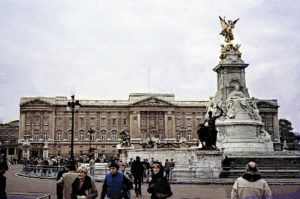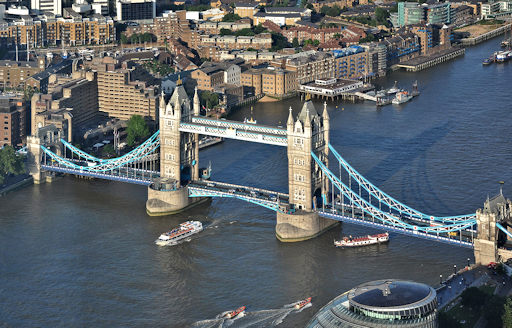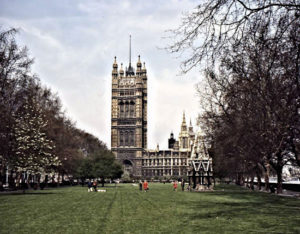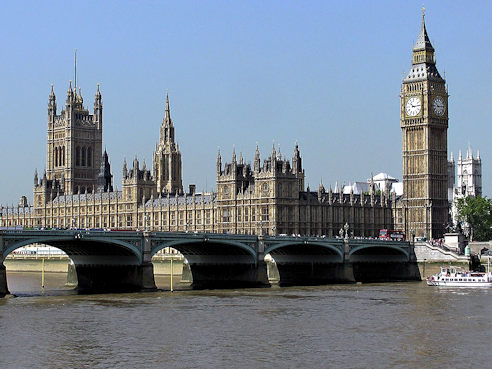Chapter 8 – England, London
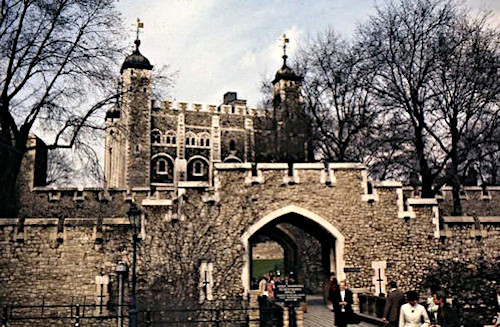
The Tower of London, the oldest fortress in Europe. A very impressive sight with the yeomen of the Guard, dressed in their red costumes.
After my three months in Babraham, Melville invited me to come and stay with an aunt of his in London for a week or so. She lived in Berkeley Square and she was a very warm and welcoming person. I had already met her but she was now probably away on vacation. Melville rented a room somewhere, possibly a room that was associated with his job.
I had already once before gone ‘up’ to London (as the English say, no matter where you come from) during my stay in Babraham, when a very good friend of mine from school, Ragnhild, was passing through on her way back home from Paris. She was with an American boyfriend whom she had met during her semester in Paris. That way she had unfortunately managed to avoid learning to speak French, which was the reason why she was there.
Her friend, Gil, wanted to go to a well-known pub in the East End where skins of dead animals were hanging from the ceiling and everywhere and the walls were covered by thousands of names tourists had scribbled as they always seem to love to do. Leaving their mark, I suppose. I found the place pretty gruesome since I am an animal lover, but Gil thought it was terrific (Oh Americans!) and it didn’t seem to disturb Ragnhild either.
This time I was really going to get to know a bit of London, sometimes in the evenings with Melville, who worked as a van guard (a guard sitting next to the driver of a van that delivers money to banks) during the day, but I mostly discovered London in my own during the daytime. I walked around, taking buses and the underground (‘the tube’). But I walked and walked and walked. I quickly learned that when you take a bus in those days, instead of telling the ticket collector where you were getting off, you could just tell him you wanted a twopence ticket or a twopence halfpenny or whatever. Since it sometimes happened that I took a similar bus ride, it was fun to just say twopence please, like a real Londoner. It seems amazingly cheap today, but then, ten years later, it was 10 cents in New York City for a bus or for a subway ride. Public transportation was subsidized, by the state I suppose. In Sweden, even trains were cheap way back then.
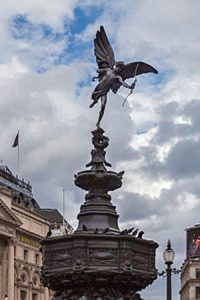
Shaftesbury Memorial Fountain, usually called the Eros who is at the top of the fountain (Wikipedia,)
I had tea of course inLyons Corner House at Piccadilly Circus and the Guinness moving sign across the plaza was an unforgettable sight. GUINNESS TIME and the huge clock that had been there forever. I don’t know if it was damaged during the war and replaced. But in 1955 the Guinness sign was a moving lights ad. That sign is gone now and I believe it is replaced by — what do you think? Mac Donald and TDK signs, among others. How could they be so lacking in a feeling of tradition, what we call “pietet” in Swedish. I was just attached to the Guinness sign, even though I don’t really like Guinness. To me it would be like taking down the Eros statue and replacing it with Maggie Thatcher.
The Eros statue in the center of Piccadilly Circus was probably the favorite meeting place in central London. You would sit down on the steps going down from the Eros, eat you sandwich or just wait for your friend. People would say “See you at the Eros at 2 p.m.”
When John and I were there a couple of decades later the Eros had been surrounded by ugly railings as if they really wanted to keep anyone from stealing the statue. I was very disappointed, but it seems to be back to normal now. I guess you can sit on the steps around the Eros once again.
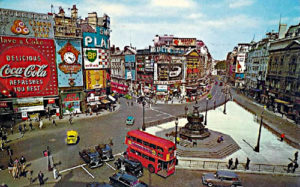
Piccadilly Circus with the Eros statue in the foreground in 1964: The huge Guinness Time clock still there – Guinness Collectors Club
London hadn’t yet recovered from the huge wounds caused by the German bombs. My first surprise was Leicester Square. Just a stone’s throw from Piccadilly Circus and Shaftesbury Avenue in the West End. Here was Leicester Square, still clearly showing huge scars from the bombing during the war In 1955. Reconstruction was undoubtedly going on, but my shock at seeing bombed-out buildings around this West End square was such that the destruction was all I could see.
Some of the famous cinemas and theaters were reopened only in 1962 and the great new Church of Our Lady of France was reopened in October that same year.
But even worse was to come on my wanderings around London. It was well known that St Paul’s Cathedral had been saved miraculously in the midst of a sea of bombed-out areas. The East End had been the worst hit in all of London, since the Germans wanted to destroy the harbor. The City of London, also east of the center, had been another one of the major targets of the German bombs, but it seemed to be completely restored. Money oblige.
This was ten years after the end of the war and I was stunned at what I saw close to St Paul’s Cathedral. The one thing that had been done at the time was removing all the skeletons of the burned-out buildings, and the area around the cathedral was nothing but rubble. And there was rubble all the way to what is now the ‘Barbican Centre,’
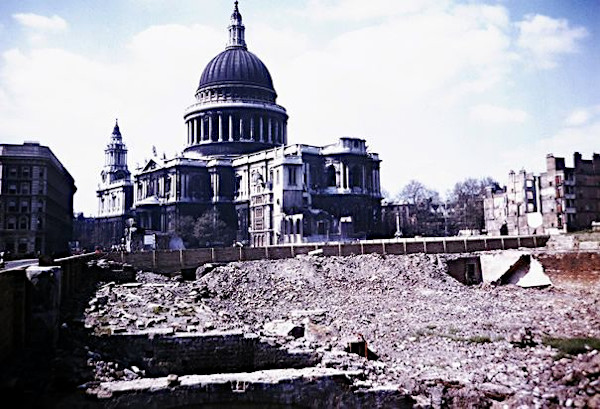
Home Front in Britain 1939-1945. Amazingly, this is not very different from the way I saw St Paul’s Cathedral in 1955.
I walked down the Strand from Trafalgar Square. I got onto Fleet Street with all the major newspaper buildings still having their offices there. At some point even before I got to St Paul’s Cathedral; I saw nothing but bombed out buildings and rubble, especially towards the north. I felt as if I’d been dropped in London right after the Blitz.[1. On the night of December 29, 1940, Daily Mail chief photographer Herbert Mason was fire-watching on the roof of the newspaper’s offices between Fleet Street and the Thames. The Luftwaffe’s blitz on London was at its height: after a brief pause decreed by Hitler on Christmas Day, Goering’s bombers had resumed their almost nightly pounding of the capital. …When darkness fell on December 29, the Heinkel and Dornier planes came again to launch their 125th attack since the campaign began — which inflicted unparalleled devastation on the old City of London. See the famous photo that has made history.]
It wasn’t even just ruined buildings. Right next to the cathedral there was nothing but rubble. The area that goes from Fleet Street up all the way to what is today the Barbican Centre was a wasteland of rubble.[1. A witness to the state of the area around St Paul’s in 1955: “When I returned to the city as a sixteen-year-old in 1955 to find a job, it was a sad place. It was not long since its skies had been darkened by Hitler’s bombers. My job was to take news photographs to the art editors of all the leading periodicals and newspapers of the day to see if they were interested in featuring them. The agency was based in Fleet Street. When I stepped out on my rounds I could see the massive structure of St. Paul’s cathedral 500 yards away on the top of Ludgate Hill. To the right and left as you walked up that famous hill was a wasteland of bombed out buildings. Feral cats and other creatures had made the ruins their home. All over Central London, which was my stomping ground, were similar sad sights. I could never quite understand how, amidst such destruction, Wren’s masterpiece had survived. (Later I learned that, apart from an element of luck – which some might prefer to regard as divine intervention – this was because orders had gone out from on high (not that high) that, whatever happened elsewhere, the great cathedral must be saved. The firefighters, therefore, made it their business to prioritize it.) “A city close to my heart” — Tom Mackenzie ]
I did not get back to London until 1964 and by then there was of course no trace of the war any more. But I will never forget the view I had seen of the wrecked areas surrounding St Paul’s Cathedral and reaching far up north, And when I see today the festive moving lights in Leicester Square which is one of the major entertainment centers in London, I find it hard to believe that I had once seen it in ruins with only the lights from one theater blinking in the evening darkness. My past had become history.
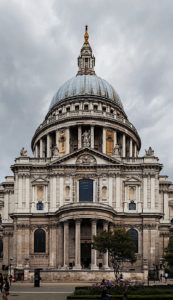
St Paul’s Cathedral in 2014 – now very carefully cleaned after all the soot and dirt from the Blitz on December 29, 1940. (Photo Wikipedia Diego Delso)
We felt the effects of the war very distinctly in many ways in Sweden, bad heating, scarce food, no hot water, suddenly a school vacation in February, because there was not enough coal to heat the buildings. We heard the planes, probably mostly British, but maybe German ones too, flying over Malmö at night and saw the huge search lights crisscrossing over the sky in the winter evenings. We had to put dark paper in our windows to darken the whole city. But we were never bombed
Well, one bomb actually fell clearly by mistake in the park close to where we lived, but it was believed to have been a British plane that dropped it carelessly, supposedly believing they were over Hamburg.
Since Sweden was supposed to be neutral, and we were clearly on the side of the British as long as politics didn’t get into the equation. we would never shoot at a British plane. However, we were ‘neutral’ so what happened was this (a true story, heard on short wave radio by my much older brother-in-law). Radio exchange between the bomber and the air force ground station in southern Sweden: “You are shooting at us. Over.” – “I know. Over” – “You are aiming too high. Over”’ – “I know. Over and out.”
So I knew vaguely about war, but I had never imagined a thing like what I was witnessing in London in 1955. And I asked myself what had happened to all the people who had once lived in the buildings that were no more? Hopefully, most of those people had been evacuated before the Blitz.
I admired the huge and beautiful St Paul’s Cathedral from the outside and from the inside. I went in of course to admire this enormously impressive interior and at least get a look at the Whispering gallery.[2. The Whispering Gallery at St Paul’s Cathedral runs around the inside of the dome 99 feet (30.2 m) above the cathedral floor. It is reached by 259 steps from ground level. It gets its name because of the acoustic effects peculiar to domes; a whisper against its wall at any point is audible to a listener with an ear held to the wall at any other point around the gallery. A low murmur is equally audible.], even though I didn’t climb the more than two hundred steps to get up into it. But the scene around the cathedral had moved me profoundly. I can see now that the ruins that were left after the bombings had been removed in preparation for reconstruction of the area, but at the time I found it hard to believe how completely that huge area had been destroyed.
________________
Of course I had a good map of London, as I always do when I visit big cities. I love maps and there’s nothing like knowing what is north and south in a city to get your bearings. I did all the usual tourist things, walking down the Mall from Trafalgar Square to Buckingham Palace and I even saw the changing of the Guard which was hilarious. You can look up into the face of one of the guards in their booths wearing their bear skin hats and they won’t bat an eyelid. But you don’t want to torture the poor man for more than a couple of seconds of course. He has his orders.
It is as if you were looking at a wax statue at Madame Tussaud’s. Which I also saw by the way, but I am not an amateur of wax museums, even though the skill it takes is pretty amazing. I am much more interested in good photography to show us scenes from history, such as what you see at Checkpoint Charlie in old Berlin, before the wall came down. The museum may still be there. I am sure it is.
On my way to Madame Tussaud’s I walked up Baker Street and being a Sherlock Holmes fan (I’ve now read or re-read everything Conan Doyle wrote about his hero and a lot more that was written much later about Sherlock Holmes by other writers, and that are not bad at all), I obviously was thinking of one of the very first sleuths in literature when I walked past what would have been his building, expecting to see Mrs Hudson looking out from behind a curtain. But there is no 221B Baker Street. There is a museum at an address that’s been made up much later on, as 221B.
What John and I did on one of our visits to London though was go to the Sherlock Holmes pub down south off Whitehall and very close to Trafalgar Square. There too, there’s a room upstairs with memorabilia of the great detective.
The pub was fun and the ambiance was great. I asked for a pint of bitter, the same as John, and I was told by the bartender that a lady doesn’t ask for a pint of bitter. I said OK, half a pint. He also kidded me for my American pronunciation. So I said “OK, half a pint of bitter. Is that bedder?” I blew it again. But I am jumping ahead here, by almost twenty years.
All right, I was on my way to Madame Tussaud’s from Oxford Street. When you get to Marylebone Road you turn right and you are almost there. I had no idea at the time of course how the name of that street is pronounced. But I learned. There’s no Mary in the pronunciation. You say marlebun, as I’ve been told. Bus drivers are good men to let you know about strange pronunciation of street names. That is, if you get what they are announcing at all.
When my stepfather, Arne, was once in London and wanted to get to Holborn (probably to see Covent Garden), he asked a cab driver to take him to Hole-born in his best Swedish enunciation. The man had no idea what Arne was referring to. So Arne tried various ways of pronouncing it and finally one way he said it made the cab driver’s eyes lighten up. Oh, you want to go to Hubben he said. Well, there are different ways of pronouncing that tricky street name, but the cab driver got it finally. Ho-ben is accepted too.
I took the tourist boat from Westminster to the Tower of London, which dates from the days of William the Conqueror (1066 and all that). Amazing. This extremely impressive palace is the oldest fortress in Europe and it was great fun seeing the yeomen of the Guard, originally the royal body guard. They look so funny in their old costumes. And here, the men talk to you. They are not like wax statues at all. They move and they talk. I cared less for the Crown jewels. A one hundred and some carat diamond that was stolen from India is a bit obscene in my opinion.
On my lone wanderings through the city, I never thought of going into a pub. It seemed that a lone woman just does not do that and I do think the English agree, or at least they may have at that time. Unless it’s a saloon bar and it’s where elderly little women get their glass (or glasses) of sherry and a daily chat with their women friends. This may less be the case for London pubs though.
But my shyness about going to a pub alone was how I didn’t discover that the best place to get a good and inexpensive lunch is exactly in a pub. Instead I found that cinemas like the Odeon, right next to Marble Arch also have restaurants where they serve lunch for a very reasonable price. John and I have found out, much much later, that the best place for a good and inexpensive lunch is a good pub.
While I was at Marble Arch I went to see the Speakers’ C’orner of course. It’s very funny to stand there and listen to a man or a woman, standing on a soap box, rambling and ranting against what they consider an affront to civilized society, against something that should be set straight by the Parliament. Some that you hear express themselves very well and might even have a reasonable cause, but the fun is that it’s probably the only place in the world where a person can stand up on a soapbox and ramble off to a sometimes sizable audience who will even once in a while applaud.
From the Speaker’s Corner I walked down south through Hyde Park and chuckled
at all the people who were lying around in deckchairs sunning their faces. Not much nakedness there, mostly dosing and day-dreaming. Swedes love to sit around in the sun too, as soon as it peeks out in the spring, but if we find a lawn we’re allowed to walk on we lie down on the grass. But all these sunbathing people looked very comfortable in their deckchairs.
I got to Hyde Park Corner and took a peek at Knightsbridge. But I did not go to Harrods, the most exclusive department store, not this time.
Melville had once taken me to a very decent pub in Cambridge. We went to the saloon bar, also called the private bar. The area behind the bar, where the bartenders were very busy pouring draft beer, went right past a division into the public bar. That’s where the workers go when they come back from a day’s hard work and want a pint of bitter or a Guinness. They feel that they are dirty and not fit for polite company. So the divisions were made to make the working men in their overalls feel comfortable. And of course the little sherry drinking ladies as well. In fact, I have never known a country where class divisions are as obvious and as accepted as in England.
All right, so we were in the saloon bar and I saw a copy of Punch on one table. Until then Punch had only been a joke to me. I had never really seen a copy. My only acquaintance with Punch is a cartoon I had been told about as coming from Punch Magazine. It takes place in a men’s club, no sorry, a gentlemen’s club, where one man says to a seriously nodding man. ‘Excuse me sir, but are you reading the paper you’re sitting on?’ I am told that Punch magazine doesn’t exist any more. What a shame! No, I mean, what a pity – of course!
In my wanderings I of course visited Westminster Abbey and saw the Poets’ corner. This beautiful cathedral has been the coronation church since 1066 and is the final resting place of seventeen monarchs. I was very much impressed by that whole section of the city, the Houses of Parliament and Westminster Abbey right next to the Thames, at the southern end of the wide street named Whitehall. The cathedral is a beautiful sight, and it is certainly one of the most impressive gothic churches I have ever seen. The Palace of Westminster, as the name goes for the Houses of Parliament, is just as impressive.
_______________
The high points in my rather brief stay in London were The Royal Albert Hall and the Royal Festival Hall, which was just a few years old at the time, a magnificent modern building.
Melville, my wonderful friend, took me to a concert at the Festival Hall. I don’t remember what we heard but it was just such an experience to be in this extremely modern and grandiose concert hall. I was probably too impressed after being used to concerts at our Malmö Stadsteater, which is infinitely less grandiose, to really notice or at least remember what they were playing.
But the most memorable evening was at the Royal Albert Hall, a Promenade concert (called the Proms), which was something I had vaguely heard about. The prices are lower than at ordinary concerts and over one thousand people have standing places in the middle of the floor and were either standing or sitting on the floor. Hence promenade concert. I don’t know how many hundred seating tickets are sold. Fortunately, we did have seats though.
The famous hall is situated on Kensington Road, which comes after Knightsbridge going west, south of Hyde Park. Queen Victoria had it built in memory of Prince Albert, the prince consort, and right across from the concert hall is the very gothic Albert Memorial right at the edge of Kensington Gardens, the western continuation of Hyde Park.
My summer in England had come to a close. In the letter exchange that followed, Melville asked me to become his May Queen the following year. It was with a heavy heart that I said “No, I didn’t think that would be possible”. For one thing I could not have afforded a trip to England for no other reason than to attend the May Ball. But the really important reason was of course the fact that I didn’t want to commit myself to Melville, no matter how nice he was, and how dear a friend.
Continued: Chapter 9 — Lund, a Love story
